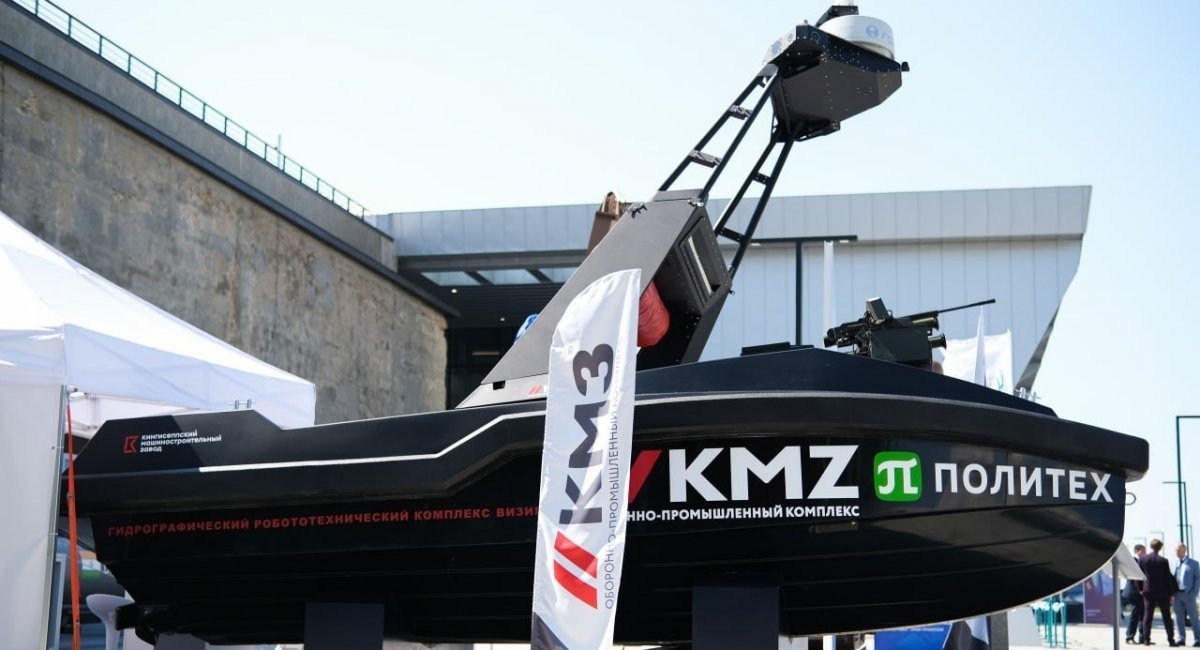In a bid to narrow the technological divide with Ukraine, Russia is intensifying efforts to develop one-way attack uncrewed surface vehicles (OWA USVs). This technology has gained significance in the maritime sector following Russia’s invasion of Ukraine.
Su-34: Russia Upgrades UMPC Software For Bomb Release; Trains Fullback Fighter Pilots For UMPC Ops
On December 1, the United Kingdom’s Ministry of Defense took to X (formerly Twitter) to announce that the Russian defense industry is actively working to eliminate the capability gap with Ukraine in OWA USV development.
According to the latest intelligence update from the UK Ministry of Defence, on November 27, 2023, Mikhail Danilenko, the head of Russian firm KMZ, declared that their Uncrewed Surface Vehicles (USVs) are set to undergo trials during the ‘special military operation.’
Moscow has plans to commence series production in 2024. Danilenko underscored the boat’s capability to carry a munition payload of up to 600 kg.
The Ministry added that although KMZ has a history of manufacturing various types of USVs, recent months have seen a shift in focus towards promoting their OWA capabilities.
While navies have employed USVs since the Second World War, their modern iterations, resembling speedboats laden with explosives, have assumed pivotal significance in the maritime domain, particularly in the hands of Ukrainian forces in the aftermath of Russia’s full-scale invasion of Ukraine.
To date, several Russian vessels have sustained damage in the wake of the one-way attack by uncrewed surface vehicles (OWA USVs). Reports indicate that these OWA USVs have successfully breached harbor defenses, causing significant damage to ships within protected anchorages.

In a recent development, Russia successfully seized an intact Ukrainian Maritime Autonomous Guard Unmanned Robotic Apparatus (MAGURA) V5 Uncrewed Surface Vessel (USV) that encountered malfunctions and washed ashore.
Images of the drone surfaced on the internet on November 22, with a Russian Telegram channel asserting that the Unmanned Surface Vessel (USV) was allegedly attempting to attack Russian ships in western Crimea “when it fell into Russian hands.”
Experts said that capturing this vessel, however, could potentially enhance Russia’s capability to develop their Uncrewed Surface Vessels (USVs).
Ukraine’s Effective Utilization Of OWA USVs Against Russia
In October 2022, Ukraine initiated its Uncrewed Surface Vehicle (USV) campaign against Russia, employing several USVs to target Sevastopol in Crimea, the home of Russia’s Black Sea Fleet.
Since then, a series of attacks have occurred on various targets, exemplifying Ukraine’s ongoing maritime efforts.
In May, a targeted strike hit the Russian Navy intelligence ship Ivan Khurs in the deep waters of the Black Sea. Following this, an attack occurred on the Kerch Bridge in July.
In August, a Ukrainian Uncrewed Surface Vessel (USV) struck the Ropucha-class Olenegorsky Gornyak near Russia’s Black Sea port of Novorossiysk.
The effective utilization of Uncrewed Surface Vessels (USVs) in the Ukraine conflict highlights their numerous advantages over traditional manned vessels, making them increasingly appealing to naval forces.
Several nations, including the United States, have invested substantially in acquiring medium, large, and extra-large “unmanned vehicles” designed for surface and underwater operations.
Naval forces are developing uncrewed and autonomous capabilities worldwide to stay at the forefront of maritime innovation. Key participants in this global pursuit include China, the UK, the USA, and Australia.
Eliminating human crews from naval vessels enables the realization of several operational efficiencies. This allows vessel design to prioritize functionality over human-centered features like sleeping quarters, galleys, life rafts, and life jackets.
As a result, a more streamlined approach produces smaller, cost-effective vessels that exhibit enhanced speed, extended operational capabilities in adverse conditions, and a minimized risk of human error or injury.
Vice-Admiral Roy Kitchener, US Naval surface forces commander, highlighted in December 2022 that Unmanned Surface Vessels (USVs) would act as a “catalyst for innovation” within the US Pacific fleet.
He stressed, “The implementation of unmanned systems will increase decision speed and lethality to enhance our warfighting advantage.”
This underscores the ambitious vision of the United States concerning the deployment of uncrewed surface vehicles, as evidenced by its plans to potentially have more than half of the US naval fleet comprised of uncrewed vessels by 2052.
Similarly, Russia’s endeavors to narrow the gap with Ukraine also underscore how these drones have altered the dynamics of the ongoing war.
- Contact the author at ashishmichel(at)gmail.com
- Follow EurAsian Times on Google News